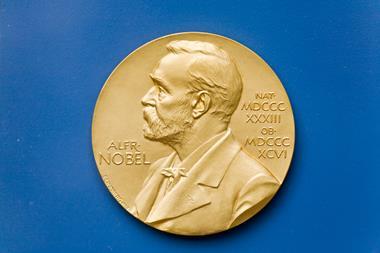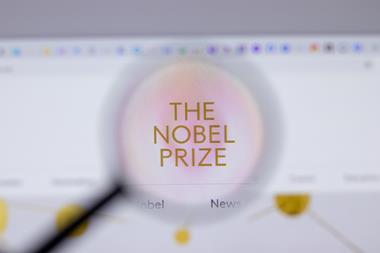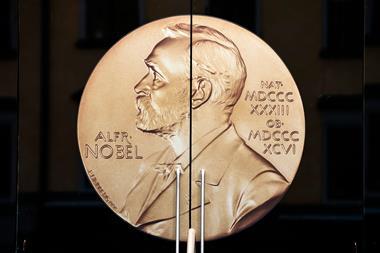Who nominated whom for the biggest prize in chemistry
Every year, the award of the Nobel prize in chemistry is accompanied by a chorus of questions that are as much a part of the occasion as the announcement itself. Is this really chemistry? Why didn’t so-and-so win? Who’s been overlooked for another year? Most of them will never be answered, but we can at least get some hints about who’s been in the running and who’s been snubbed by looking at the Nobel nominations archive.
The Nobel committee keeps the nominations and its discussions secret for at least 50 years, so we’ll have to wait a long time before we find out who else was nominated this year, but the first 70 years or so of nominations are available. Still, it’s hard to get an overarching picture of the whole story by browsing those records, so we’ve taken a different look at the whole database using some of the network plotting techniques from our Holy Grails series of articles in 2020.
Since 1901, over a thousand scientists have been invited by the Nobel committee to nominate their chosen winner or winners for that year’s prize, nominating more than four thousand people. We’ve divided the data into decade-long chunks to make the network diagrams a little easier to read, then looked at a few scientists in detail to see what we could find.
The first decade of the Nobel prize, from 1901 to 1910, is one of the simplest. In the visualisation below, nodes are scientists, and connecting arrows point in the direction of a nomination. The colours refer to whether someone won the prize in the decade in question (pink), in a past (purple in the rest of the visualisations) or future (blue) decade, or not at all (grey). It’s easy in this visualisation to see that Henri Moissan received plenty of nominations, which resulted in him winning the prize in 1906. William Ramsay, Adolf von Baeyer, Wilhelm Ostwald and Svante Arrhenius are other large pink nodes (indicating they won the prize in this decade), while it’s interesting to see that Eduard Buchner won the prize in 1907 after just three nominations. Dmitri Mendeleev is a grey node with several nominations, including laureates Jacobus van ’t Hoff and von Baeyer, but he never won the prize – perhaps his great achievement was too long in the past? Walther Nernst, Theodore Richards and Alfred Werner are already gathering nominations ahead of their future prizes, hence their nodes being coloured blue.
The next decade, between 1911 and 1920, is again relatively simple, perhaps reflecting science’s smaller number of practitioners over 100 years ago, as well as the gap in awarding prizes during the first world war. Richards, Richard Willstatter and Nernst are the largest nodes, and won the prize in 1914, 1915 and 1920 respectively. Theodor Curtius received many nominations, as he did in the previous decade, but never received the prize. Von Baeyer and Arrhenius are small blue nodes in this visualisation having won the prize the previous decade, but their influential nominations to others result in a prize in eight of their 14 nominations.
But can you find Marie Curie in the network? She won the prize in 1911, but received just two nominations that year (she also received three nominations for the physics prize in 1902–3).
The 1920s looks like the decade of people with many nominations, but who never won. Those large grey nodes include Curtius yet again, Georges Urbain, Gustav Tammann and Gilbert Lewis (more on him later). There’s a noticeable increase in complexity in this decade compared to the two previous ones. It’s interesting to see that Francis Aston, who won 100 years ago in 1922, was only nominated by one person for chemistry – but he was also nominated three times that year for the physics prize. In spite of Walther Nernst receiving the prize in 1920, he was also nominated 22 times in 1921, which is fairly unusual. Were they suggesting he should have won again, or were they unaware of his recent recognition? We’ll need a visit to the Nobel archives in Stockholm (and a translator) to find out.
One highlight of the 1930s is the appearance of Otto Diels, who went on to win the prize in 1950 with Kurt Alder (who else?). Yet in this decade, Diels was nominated by lots of people but Alder only by one. Robert Robinson also appears with plenty of nominations from past winners and those who won in this decade. Christopher Ingold is one of several people to nominate Peter Debye, who won in 1936. We’ll have more on Robinson and Ingold later…
Marie Curie’s daughter Irène Joliot-Curie and son-in-law Frédéric Joliot carry on the family tradition of winning prizes but being hard to spot! Joliot-Curie was nominated several times for the physics prize in 1934 and 1935, but won the chemistry prize in 1935 with only three nominations.
With the publication of Linus Pauling’s seminal book The Nature of The Chemical Bond in 1939, the 1940s sees him gather many nominations. Hermann Staudinger, credited with the discovery of polymers, received many nominations in this decade having been first nominated in the 1930s. Robinson won the prize in 1947, receiving nominations in this decade from past and future prize-winners. Those receiving plenty of nominations but missing out are Tadeus Reichstein, Fritz Kögl and Gustaf Komppa. Reichstein went on to win the medicine prize in 1950, and Kögl was nominated many times between 1934 and 1951, presumably for his work on the plant hormone auxin.
After a few nominations in the 1940s, Robert Woodward gathers many more in the 1950s, eventually winning the prize in 1965 after a record 111 nominations (more on him later). But Woodward is not the most nominated person in this decade: Walter Reppe received over 50 nominations, but never won – possibly because of his associations with the Nazi regime during the 1930s and 1940s. Ingold again received many nominations, as he would do in the following decade. Cyril Hinshelwood had been nominated a few times in the late 1940s, and after six nominations in the 1950s won the prize in 1956 for his work on reaction mechanisms. Fred Sanger, who won the prize in 1958 after 17 nominations, should be both blue and purple in this visualisation, as he went on to win the 1980 chemistry prize too. As the 1980 prize was for work published in 1977, the nominations that led to it are not yet in the public domain.
The 1960s, the last decade for which nominations have been released by the Nobel foundation, is dominated by Woodward. It’s interesting to see that although Giulio Natta and Karl Ziegler shared the 1963 prize and their names are now firmly linked in our minds, not many people nominated both of them – it looks as though Natta was nominated by many Italians, who did not also nominate Ziegler. Lawrence Bragg, winner of the Nobel prize in physics in 1915, appears to have been a particularly influential nominator in this period: his picks of Max Perutz, John Kendrew and Dorothy Hodgkin were all winners. Bragg also tipped James Watson, Francis Crick and Maurice Wilkins in 1962, the year they won the physiology and medicine prize.
Neil Bartlett, who prepared the first compound of a noble gas (xenon hexafluoroplatinate), was nominated 45 times between 1963 and 1970, but never won the Nobel prize – although his achievements were such that Primo Levi wrote that he had won the prize on the very first page of his classic 1975 book The Periodic Table.
The absence of female scientists is a problem raised almost every time the Nobel prizes are announced. This visualisation shows the network of women nominated for all science Nobel prizes, not just chemistry, across the entire range available (1901 to 1970). It’s incredibly meagre – in chemistry, only 67 of the 4306 nominations between 1901 and 1970 were to women (just 13 individuals). Dorothy Hodgkin received the most chemistry nominations with 24. Max Planck gave the most nominations to a woman, Lise Meitner, whom he named six times between 1929 and 1937. Let’s hope that when we look at the nominations again in 50 years’ time, the diagram looks a lot more complicated.
Nominations by numbers
- Most prolific nominator: 1929 laureate Hans von Euler-Chelpin, who named 60 people from 1907–1960
- Most accurate nominator: 1926 laureate Theodor Svedberg, who nominated 17 winners from 1916–1954
- Worst nominator: 1944 laureate Otto Hahn, with 15 non-winners from 1929–1964
- Least nominated laureates: Francis Aston (1922), Arthur Harden (1929) and Harold Urey (1934) all received only one nomination for the chemistry prize
- Most nominated laureate: Robert Woodward (1965, 111 nominations)
- Most nominated non-laureate: Christopher Ingold (112 nominations)
- Year with fewest nominations: 1918 with 11
- Year with most nominations: 1969 with 233
Dividing the data into decade-long periods has some advantages, but it can obscure what happens to people and their nomination networks over several decades. To rectify this, we’ve looked at a couple of rivalries and some stellar chemists.
Gilbert Lewis – US chemist, head of the chemistry department at the University of California, Berkeley, responsible for much of our understanding of covalent bonding as well as his theory of acids and bases. He very much sounds like the kind of person who should have won a Nobel prize, yet in spite of 41 nominations he never did. Is it because he fell out with Walther Nernst, his post-doctoral adviser who was highly influential with the Nobel committee? Irving Langmuir was also one of Nernst’s post-docs and won the prize in spite of working in industry for General Electric rather than academia. Looking at the nomination network for the two of them shows very little overlap and a couple of surprising facts: Nernst nominated neither of them, but Langmuir did nominate Lewis, which somewhat puts paid to rumours of animosity between them.
In terms of animosity, there aren’t many academic feuds that beat the one between Robert Robinson and Christopher Ingold. This seems to have begun after a disagreement at a Chemical Society meeting in 1925 – and then lasted for the rest of their lives. Although both are now credited as equally important in putting organic chemistry on a rigorous and electron-based footing, Robinson thought that Ingold had appropriated his ideas without giving him enough credit. Their nomination network, when considering that they both worked in the same field and were based in the same country (Ingold even replacing Robinson at University College London after he left for Oxford), has remarkably little overlap. Only four people, Tadeus Reichstein, George Finch, Leopold Ruzicka and Edmund Hirst, nominated both of them for the prize – out of 112 nominations for Ingold between 1940 and 1970 and 51 for Robinson between 1928 and winning in 1947.
Linus Pauling was one of the most influential chemists of the 20th century, whose work on bonding revolutionised our understanding of the whole discipline. To see his nomination journey to a Nobel prize, we’ve created this short video that shows how many nominations he got over the years leading up to winning. Pauling is of course one of the very few people to win two Nobel prizes, receiving the peace prize in 1962 after three nominations. What’s more, he was even nominated for the physiology and medicine prize in 1953.
While Pauling came from an inorganic/physical background, Robert Woodward was from the organic side of chemistry, and was probably the pre-eminent synthetic organic chemist of the century. We’ve made a similar video to show how and when he gathered the many nominations that led to his prize, together with some of his synthetic achievements.
Woodward himself wrote to the Nobel committee after the 1973 prize was awarded to Geoffrey Wilkinson and Ernst Fischer (for ‘their pioneering work on organometallic, so called sandwich compounds’), suggesting he should have shared in that work – he and Wilkinson had worked out the structure of ferrocene in 1952. But he wasn’t nominated for the prize after his win in 1965, and nobody who nominated Wilkinson and Fischer also nominated Woodward (at least up to 1970, the limit of the nomination archive).
Come back in eight years’ time when we can add the 1970s nominations to the collection!












No comments yet